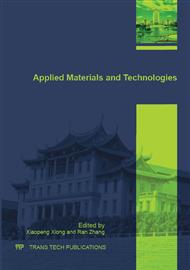[12]
with the Fe2O3 content increasing in rare material, the alumina reduction rate increased obviously. The experiment result shows that the Al2O3 recovery ratio is 55. 6 and 79. 8% respectively before and after adding of Fe2O3. In order to reduce energy consumption, it is expected to accelerate reaction rate with adding a certain amount of Fe2O3 in rare material when reducing Al2O3 and SiO2 to Al-Si alloys, and it has been successfully applied in industrial practice.
Google Scholar
[4]
Preliminary Experiment The CFA samples in this study were provided by a power plant in Yunnan province, China. The CFA phase chemical composition and mineralogy analysis are presented in Table 3 and Fig. 2 respectively. Fig. 2 shows that quartz (SiO2), mullite (Al6Si2O13), hematite (Fe2O3) and magnetite (Fe3O4) are the main crystal mineral phases in CFA. Table 3 lists the chemical composition of CFA analyzed by XRF. The content of (SiO2+Al2O3) is close to 70%, while the content of Fe2O3 is much higher than the standard of Fe2O3crit(CFA). Therefore, it is necessary to reduce the iron content before carbothermic reduction. Table 3 Chemical composition of Yunan CFA (wt. %). SiO2 Fe2O3 Al2O3 CaO TiO2 MgO SO3 Na2O K2O LOIa.
DOI: 10.1007/s10720-005-0009-9
Google Scholar
[3]
92 aLOI: Loss on ignition- a test designed to measure the amount of moisture or impurities lost when a sample of material is ignited under a specified temperature until its mass ceases to change. Fig. 1. Simplified liquidus projection of the ternary Al-Si-Fe system. Fig. 2. XRD patterns of the CFA Hydrometallurgy as an important pretreatment process is more economical because of lower capital and operating costs, more cost-effective and environmental-friendly to remove iron from CFA. It is relatively easy to remove iron from CFA via hydrometallurgical method. The direct acid leaching experiments over CFA indicate that the iron removing rate reaches up to 90% while the alumina loss rate remains low (<10%) after two-stage leaching process. It can be taken as high quality raw material to prepare Al-Si alloy.
Google Scholar
[5]
Conclusion In a summary, the critical Fe content depends on the silicon level of the alloy. Iron content above the critical value, resulted in the formation of β-phase platelets prior to the Al-Si eutectic, and when this occurred there was an increased tendency to form extensive and damaging shrinkage porosity defects. While it goes against the subsequent carbothermic reduction when the iron in a very low content. Thus a compromise had been made between the desire for accelerating reduction reaction rate and meeting the requirements of the raw material. Results indicate that the optimal route to prepare the qualified Al-Si alloys products is to remove most of the iron from CFA using hydrometallurgical pretreatment method before carbothermic reduction. Other pyrometallurgy refining methods are applied to further deironing the primary Al-Si alloys. The critical iron content in CFA should meet the equation Fe2O3crit(CFA)=0. 047×[Wt%SiO2]-0. 794. The preliminary experiment results indicate that the Fe2O3 content in pretreated CFA consist with this formula well. Acknowledgement The work was financially supported by the National Natural Science Foundation of China (No. 51064014) and the province Natural Science Foundation of Yunnan (No. 2010CD025).
Google Scholar


